

Be in the Know
Elevate your industry knowledge with yoga articles and insights crafted by experienced industry experts
We all know that a regular yoga practice has an array of positive health benefits and many people are in fact attracted to yoga in search of a cure for their ailing health, especially musculoskeletal conditions. The physical limb of yoga (asana) involves students performing a number of postures, both static and dynamic, through a variety of movements that result in a greater level strength and flexibility.
Clearly this is of real value to the physical body, in particular the spine. This is because yoga postures, when practised with complete focus, encourage the muscles that provide support to the spine and its connective tissues to work in unison with the abdominal and deep core muscles, creating a functionally integrated and mechanically efficient unit from which quality patterns of movement arise. Before we dive into the postures however, it is worth revisiting the basic anatomical features of the spine.
The spine is an intricate structure made up of twenty-four small bones called vertebrae which that are stacked to make a column-like structure that surrounds and protects the spinal cord. The spinal cord is a complex structure that connects the brain with the rest of the body and communicates via nerve signals which are sent through the thirty-one pairs of nerve roots. These roots exit the spine on either side through spaces called neural foramina between each vertebra, allowing us to control our movements and have optimal organ function.
Between each vertebra is a disc which is formed of a soft, gel-like cushion, the function of which is to absorb impact and pressure and also prevents friction between the vertebrae. The vertebrae of the spine are connected via facet joints and is held together via a network of connective tissue consisting of ligaments and tendons whilst the surrounding skeletal muscles offer much-needed support.
For anatomical purposes, the spine is divided up into four main sections. These include the cervical spine which is made up of seven bones and includes the neck. There is generally a good deal of movement in this part of the spine, especially rotation. The centre of the spine is known as the thoracic spine and consists of twelve vertebrae. Side and forward flexion and extension are fairly easy movements for this segment of the spine but rotation is limited.
This can, however, be improved through yoga postures that involve twists. The lower back is known as the lumbar region and is made up of five vertebrae, (although some people have six). Because of its close proximity to the pelvis, there is limited movement here and although a yoga practice can increase this movement, extreme stretches in this area may also lead to instability and so should be done with caution. The sacrum, the base of the spine, is a group of tiny fused bones which act as an attachment site for the pelvis, the lower part of which is known as the coccyx.
When the spine has optimum postural alignment it will have an ‘S’ like curve which helps the spine absorb impact and distribute body weight more evenly as well as maintain balance. When postural alignment issues become apparent however, more pressure is placed on certain areas of the spine and dysfunction can occur.
An example of this would be a misalignment of the cervical spine. When the neck moves out of neutral alignment and begins to protrude forwards, muscle imbalance begins to occur creating weakness in the front of the neck and increased tension across the back of the neck, as it now working more intensely because the weight of the head is increasing due to the lever (the neck) being extended forwards.
So when we consider all these complexities of the spine, we can see that any training or yoga practice must place great emphasis on keeping the many elements that make up the spine, healthy. This helps us feel physically well allowing us to be more active and more sociable, thus increasing our self-confidence. And on a more subtle spiritual level, a healthy back is also a sign that one of our seven energy centres, the Root Chakra (Muladhara) is well balanced, offering us feelings of being well-grounded and stable.
When there are challenges with the spine resulting in discomfort and/or pain, the opposite can occur and the spine literally becomes unstable, having a huge effect on our physical and emotional health. Therefore keeping our backs healthy is paramount to optimum health.
The most effective way to maintain the health of the back and spine is to achieve a healthy and balanced movement pattern. This can be achieved via a yoga practice that includes postures that stretch, rotate, extend, side bend and strengthen the spine and its surrounding muscles and connective tissue.
These are all-natural movements of the spine but in our daily life, it is easy to do too much of one movement and not enough of the other, leading us to physical imbalances. Articulation of the spine, such as that shown in ‘Rolling Down’ below, is also an important movement for the spine as it helps to keep healthy mobility of the middle (thoracic) spine.
The following asana sequence will help you maintain the health of your spine by creating a healthy and balanced movement pattern.
Rolling Down
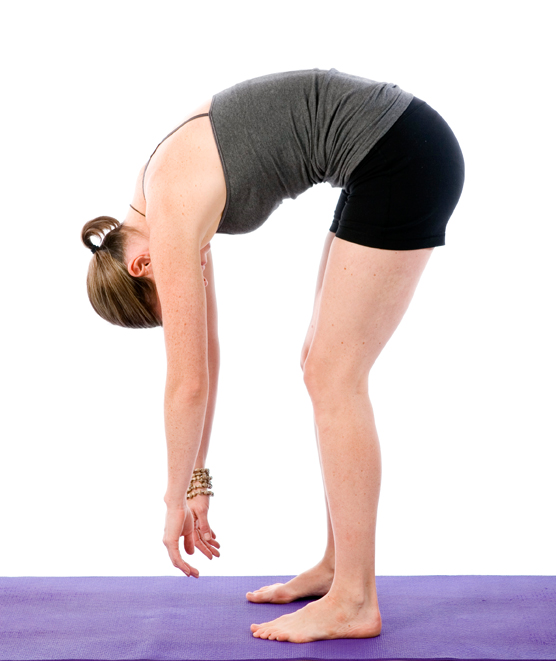
This is a great warm-up for the spine. Stand with the feet hip-width distance apart and parallel to one another. Bend the knees slightly, lightly contract the abdominal muscles and tuck the pelvis under a little.
Allow the neck to completely relax so the chin drops to the chest and start to roll down through the spine slowly with the arms completely relaxed. When the hands are about knee height (or lower if your body allows it), start to roll back up to standing, keeping the knees slightly bent. A visualisation that may help you with this movement is to imagine you are un-stacking the spine, and the restacking it as you roll back up.
Repeat 2-3 times.
Benefits: This gentle movement mobilises the spine, in particular the thoracic spine. It also stretches the muscles of the back, especially the spinal extensors, and the hamstrings. Rolling the spine in this way also improves body and postural awareness and is a mentally calming movement.
Ardha Chandrasana (Crescent Moon)
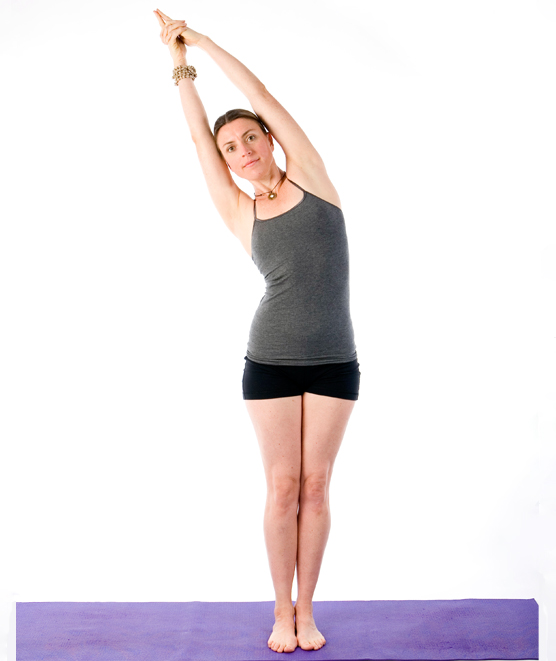
Stand in Tadasana (Mountain) and reach the arms up overhead, interlace the fingers and extend the first finger. Tuck the pelvis under slightly and drop the shoulders down away from the ears. The chin is level to the floor. Keep the legs strong and stretch the entire body upwards. As you exhale, bend sideways whilst maintaining the lift through the spine, especially in the lower back area. Hold for five breaths and repeat on the other side.
Benefits: This posture encourages a sideway bend (lateral flexion) of the spine. This is not a movement we do often other than in asana practice but is useful to keep healthy mobility of the middle spine and rib cage and its surrounding connective tissue in particular.
Utkanasana (Chair Pose)
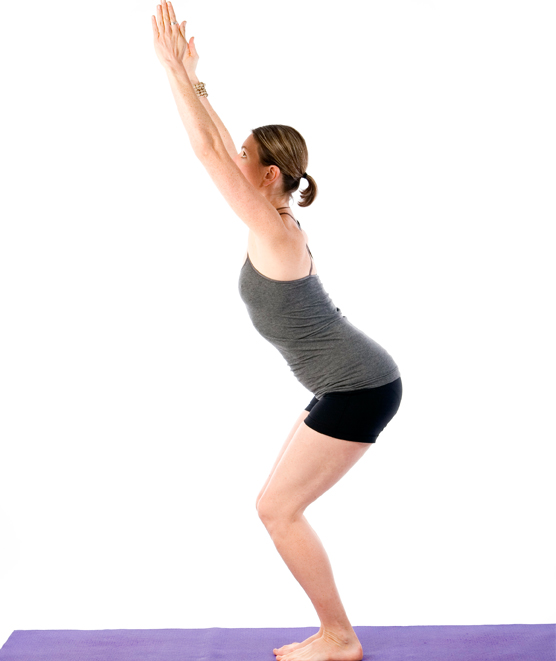
From Tadasana with the feet together, exhale and bend the knees so you are in a squat position. At the same time sweep the arms upwards so they are in-line with the ears. The hands are shoulder-width distance apart. Press the thighs together and lengthen the spine by keeping the chest lifted and the chin parallel to the ground, and draw the shoulders down away from the ears. Hold for five breaths.
Benefits: The asana encourages the spine to extend strongly and so is a great strengthening posture for the entire back area. This effect is increased by raising the arms in this posture which encourages the muscles of the back have to work even more strongly. The muscles of the abdominal area are also worked as they contract to stabilise the torso.
Parivrtta Trikonasana (Revolved Triangle)
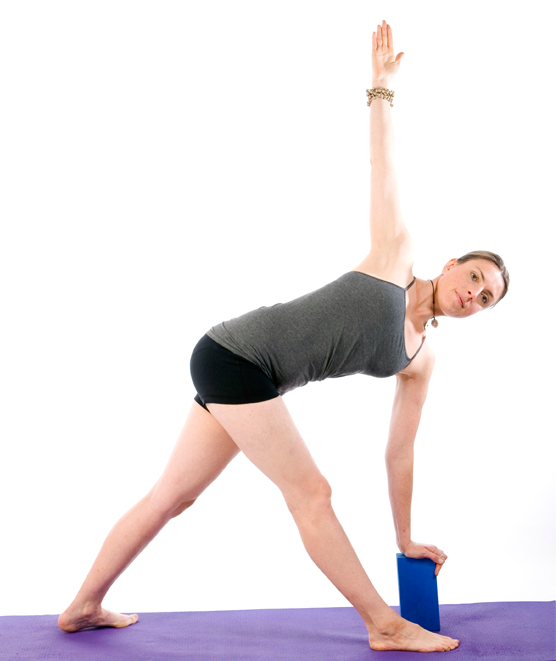
Step the feet approximately one metre apart and place the hands on the hip bones. Turn the left foot in forty-five degrees to the right and the right foot out to the right ninety degrees.
Align the right heel with the left heel. Turn the torso and hips to the right and extend the spine forwards until the upper body is parallel to the ground. Reach the left hand down to the shin or onto a yoga block (positioned against your inner right foot).
Extend the right arm up and rotate the torso so the right shoulder stacks on top of the left shoulder. Keep the chin in line with the sternum. Hold for five breaths and repeat on the other side.
Benefits: This asana rotates the spine strongly, especially the middle spine. As there is an element of balancing in this posture, the spinal stabilisers are also strengthened as they work to support the spine.
Bhujangasana (Cobra)
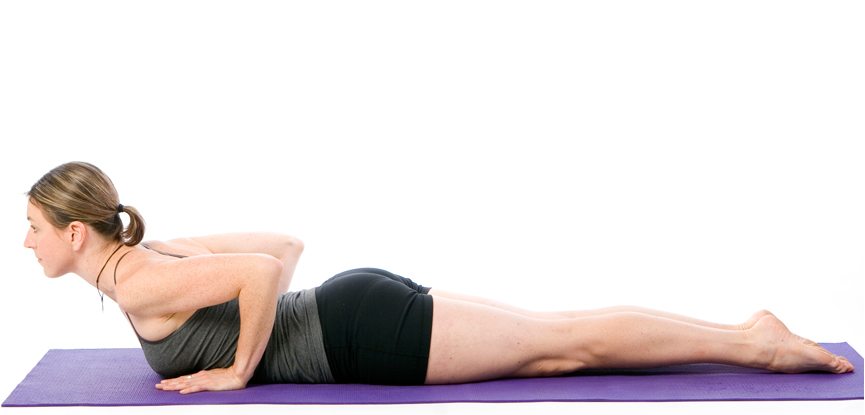
Lay face down with the legs together and place the hands either side of the chest with the arms pressed against the rib cage. Press the tops of the feet into the floor to activate the legs and gluteal muscles. Lightly press into the hands and lift the head, chest and shoulders away from the floor. Draw the shoulders down away from the ears and keep the chin level to the floor. Hold for five breaths.
Benefits: This asana stretches and extends the spine, increasing both its flexibility and strength. Cobra is also beneficial for the digestive system it applies slight pressure to the abdomen and helps to massage the internal organs.
Please note this yoga sequence is intended as a preventative measure against back pain. It is not intended for those with existing back pain.
If you have a passion for yoga and you’re interested in following in the footsteps of Sally Parkes, have a look at our internationally-recognised yoga instructor courses.
Back to articlesAnd embrace the rich and vibrant world of yoga
Great news, you're on the list...